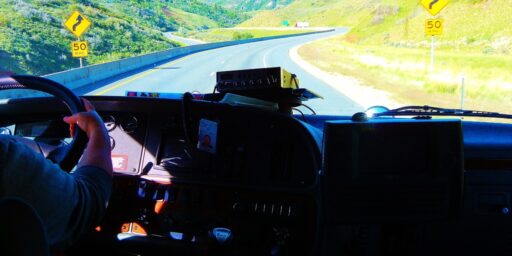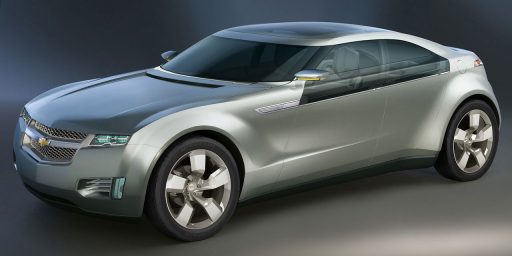California Allowing Hybrids in Carpool Lanes
California is about to join Virginia as the only states to allow solo drivers in hybrid vehicles to use high-occupancy vehicle (HOV) lanes.
Hybrid Cars Coming Soon to Carpool Lanes (AP)
Hybrid car owners are fast approaching the day when they will be allowed to drive solo in California’s car pool lanes. State lawmakers passed a bill last year that gave some types of the high-mileage, low-emission vehicles access to the coveted lanes — a privilege meant to encourage drivers to buy the environmentally friendly cars.
California’s law was supposed to take effect Jan. 1 but first needed approval from the federal government. That permission was tucked into a $286 billion transportation bill Congress passed last week, meaning there is just one last strand of red tape keeping hybrids out of the high-occupancy vehicle lanes: State air regulators need to clarify which vehicles meet the mileage and emissions standards. The policy’s supporters hope hybrids will be allowed in the car pool lanes by year’s end.
[…]
California will become the second state to allow hybrids with just one person in the car to use car pool lanes. Virginia enacted the change in 2000, and Arizona, Connecticut, Georgia and Minnesota are considering it.
In Virginia, some drivers complain that opening the door to hybrids has led to a crush of cars and slowed once-speedy commutes.
The American Lung Association of California advocates hybrids but took no stand on the car pool bill for fear it might cut car pooling and lead to more pollution. “We were not convinced that this incentive was needed and we were concerned about the potential to slow traffic in HOV lanes and discourage people from car pooling,” spokeswoman Bonnie Holmes-Gen said.
To prevent hybrids from clogging car pool lanes, Pavley’s bill expires in 2007 and caps at 75,000 the number of hybrid vehicles that could participate. Owners would have to pay about $8 for decals identifying their vehicles as hybrids to police.
The HOV concept simply does not work. People who live within the city in most metro areas with enough traffic conjestion to justify the concept tend to have access to excellent public transportation. On the other hand, carpooling is incredibly impractical for most of those who live in the suburbs. In the D.C. area, for example, people routinely commute in a radius that extends 50 miles or more and work unpredictable hours. Aside from organizing a contrived vanpool, it is virtually impossible for most people who need to drive in to actually find someone they work with who is both on the same schedule and lives in the same general neighborhood. As a result, the HOV lanes are often woefully underused, wasting precious road space.
Allowing hybrids to use these lanes helps solve some of this problem but quite possibly at the cost of public safety. Most of the qualifying vehicles currently available are much smaller than the ones people able to pay the inflated prices hybrids bring would otherwise buy. Smaller cars offer much less protection in a crash. In essence, the government is offering people a temporarily faster commute (as more people get hybrids, the advantages of the HOV lanes diminish) in exchange for a greater risk of death.





66 HOV has seemed significantly lighter lately. It may be due to increased enforcement. (My wife and I work across the street from each other, so we have a perfect setup to use 66 HOV.)
I agree that HOV is wasted space. That however doesn’t bother me as much as law enforcement neglecting to enforce the HOV restriction. On the little stretch (US50 in Prince Georges MD)of highway I have to contend with HOV lanes, a majority of those in the HOV lane do not meet the requirements. Rarely will you see law enforcement ticketing those who abuse the lanes.
The strip up 395 in DC, on the other hand, is full of HOV vehicles. Clearly there are places where HOV works.
From the perspective of “how much can we afford to spend to move N more vehicles”, HOV makes sense anywhere there are some concentrated employment destinations. (IE, it doesn’t work in Silicon Valley, but it does, generally, work in places like DC, or Dallas, or Houston).
Just wait until Virginia (and then MD supposedly) adds HOT lanes to the Beltway. Privately financed lanes that you can pay to use. Last report I saw said the first segment built would be Springfield to somewhere just south of the American Legion Bridge.
I’ve always liked HOV lanes (in appropriate proportions) on the grounds that they give priority to cars that move more passangers for a constant use of road space. Not necessarily to encourage people to carpool, simply to speed up the commute of those who do. It’s a utilitarian argument: letting a car with two passengers into an express lane gets two people to their destination faster, while letting a randomly chosen car with one passenger in only gets one person there faster.
Of course, the benefit is lost if the HOV lane is underused. The ones I’ve seen in southern California have generally been well-used during peak hours, but I expect this varies in different areas.
In Atlanta, the HOV lane is about as slow as all the others.
You realize, of course, that hybrid SUVs are coming onto the market, thus weakening your safety argument.
Bryan: Maybe. I know there’s a hybrid version of the Ford Escape, a tiny SUV, coming. I’m not sure whether it will qualify for the exemption in California, though.
Presumably, though, hybrid technology is/will be adaptable to larger, more powerful vehicles at some point.
“Smaller cars offer much less protection in a crash.”
Protection to who?
I assume you are stating that the driver of the smaller car has less protection, but what about everyone else on the road?
What you fail to consider is that driving a smaller car, while measurably more dangerous to the driver of that car, also measurably makes the roads safer for every other driver. The main reason driving a smaller car is more dangerous is because there is an obscene number of huge SUV’s waiting to stomp any vehicle they get in an accident with.
If you are truly concerned about safety, MORE small cars on the roads make them safer for everyone, not LESS.
When purchasing or driving a car, my own safety and that of my passengers is paramount. It’s the responsibility of others on the road to protect themselves.
Fair enough.
I take the more Christian viewpoint of acting toward others like I’d want others to act towards me. Jesus wasn’t to hip on the idea that we should do what’s best for us and “screw the rest,” was he?
I think the Golden Rule is in the Bible once or twice, as well as in just about every other sacred religious text.
At least you admit your viewpoint is selfish. I admire and respect your honesty.
There is only one true solution to this entire problem. Move away or continue to waste years of your life sitting in traffic. Do the math, yes, it’s years if you stay until retirement. I moved and life is much better. Traffic in these area’s will alway be terrible so put on your BGP’s or move away. The choice is yours.